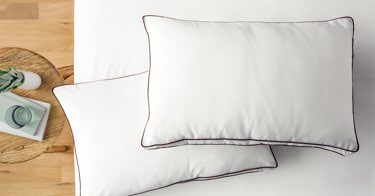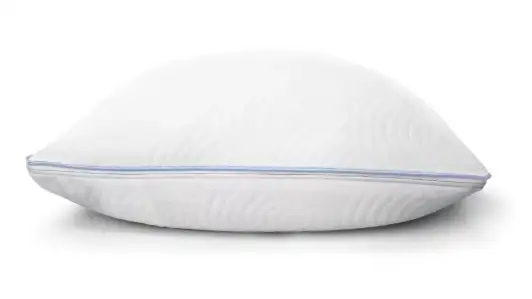Snoring is a common sleep-related issue that can disrupt a person’s rest and become bothersome to sleep partners. Certain causes of snoring, including sleep apnea, require special treatment, but for mild to moderate snoring, changing your pillow and other lifestyle modifications may be helpful.
Pillows for snoring are typically designed to elevate a sleeper’s neck and shoulders or help them maintain a sleeping position that minimizes snoring. Anti-snoring pillows come in a wide variety of types and materials, offering shoppers a wide variety of pillows to choose from.
We’ll cover our top picks for the best pillows for snoring, then delve into what causes snoring and how to choose the best pillow for your body type and preferred sleep position. Finally, we’ll offer some tips on other lifestyle changes you can make to reduce snoring and improve your sleep.
Sleep Doctor’s Picks
Shredded Talalay latex and down alternative
Medium soft
$165
Standard – 4″ to 5″, High – 6″ to 7″
Highlights
- Down alternative and breathable shredded Talalay latex reduce heat retention
- Organic cotton cover is easy to clean
- Multiple sizes to suit a variety of beds
Ideal For
- Side and back sleepers under 230 pounds
- Sleepers prioritizing a luxury look and feel
- Those who tend to sleep hot
Why We Like It
Combining the responsive support of Talalay latex with the softness of down alternative microdenier fibers, the Saatva Latex Pillow provides luxury comfort. The pillow features a breathable 100% organic cotton cover with a smooth sateen weave. Gusseted sides create structure for the lofty microdenier fill, while an inner core of shredded Talalay latex provides good support. Our testers appreciated the Saatva Latex Pillow’s superior shape retention. However, we found that the down-like airiness of its fill was too soft for our testers over 230 pounds and a poor fit for stomach sleepers across the board. That said, side and back sleepers under 130 pounds found the Latex Pillow’s medium soft feel to be an excellent fit, with the shredded latex core adding the right level of support. Saatva shoppers can select either a queen or king size Saatva Latex Pillow, both of which are slightly larger than standard. Saatva offers free shipping, a 45-day trial, and a one-year limited warranty.
Solid memory foam
Firm
$54
7″, 10″, 12″
Highlights
- Tapered design elevates the upper body
- Firm foam structure supports and gently contours to the head and shoulders
- Foams meet rigorous third-party safety standards
Ideal For
- Back sleepers
- Value seekers
- Those who want a pillow that works for sleeping as well as for watching TV or reading
Why We Like It
The Zuma Foam Wedge Pillow from Brentwood Home creates a gentle incline that lifts the upper body away from the sleep surface to relieve pressure and improve airflow. With a distinctive shape that supports the head and shoulders, the Zuma Pillow offers relief from conditions like snoring that can be made worse by lying flat. Additionally, its affordable price tag makes the Zuma Pillow a great value. Constructed from high-density support foam, the Zuma Pillow is designed to maintain its shape under pressure. It’s formulated with vegetable-based BioFoam and is CertiPUR-US certified free of many common harmful chemicals. The cover is made from bamboo-derived rayon with four-way stretch and a built-in zipper. Sleepers can select from three loft options: 7 inches, 10 inches, and 12 inches. During testing, our back sleepers across all weight ranges were impressed by the Zuma Pillow. They appreciated the options available for more or less lift, selecting a higher or lower profile depending on their body type and personal preference. The sturdy support of the foam still had some give around the shoulders for our side sleeping testers, but it should be noted the pillow is designed primarily to support people who sleep on their back. The Zuma Foam Wedge Pillow comes with a 30-day trial and a one-year limited warranty.
Shredded memory foam
Medium Soft
$69
Adjustable
Highlights
- Blend of TEMPUR fill materials offers a great mix of responsiveness, softness, and support
- Adjustable loft lets sleepers match the pillow’s feel to their sleep needs
- Optional cover upgrade engineered to improve temperature regulation
Ideal For
- Side, back, and stomach sleepers under 230 pounds
- Combination sleepers looking for a pillow that supports multiple sleep positions
- Those who want an easily moldable pillow
Why We Like It
The mix of fills in the Tempur-Pedic TEMPUR-Cloud Adjustable Pillow includes three distinctive TEMPUR materials. They work in concert to create a cloud-like feel that is moldable, closely conforming, and easily adjustable. For sleepers seeking a lofty pillow they can sink into, the TEMPUR-Cloud has a good mix of comfort and support. Our side and back sleepers had the best experience on the TEMPUR-Cloud. The pillow’s plush feel and adjustable firmness level was comfortable, providing just enough support to promote spinal alignment. However, our stomach testers over 230 pounds did not get enough support from the TEMPUR-Blend and ended up lying too flat for a comfortable fit. The TEMPUR-Cloud comes in standard queen and king sizes. Tempur-Pedic offers free shipping on pillows to the contiguous U.S., plus a five-year warranty.
Why You Should Trust Us
Our team of experts has personally researched and tested hundreds of options to bring you our picks for the best pillows for snoring. Our evaluations are based on years of experience testing sleep products with a diverse team that includes sleepers with varying body types and preferred sleep positions. The result is vetted recommendations you can use to help you decide what anti-snoring pillow best meets your needs.
Do Anti-Snore Pillows Work?
While lifestyle changes don’t work for everyone, some people find that using a wedge or special pillow to raise their upper body can reduce or eliminate snoring. Anti-snoring pillows are designed to help sleepers maintain a specific sleeping position or elevate their head and neck to keep the airway more open during sleep.
What Causes Snoring?
Snoring happens when the soft tissues in the upper airway relax during sleep. This narrows the space available in the throat and can restrict the flow of air. As each breath passes through the narrowed airway, the tissues vibrate, creating the sound we refer to as snoring.
Snoring on its own is not usually detrimental to a person’s health, but people who snore loudly or frequently may have an underlying condition called sleep apnea. Without treatment, sleep apnea can lead to a range of health problems. Because of the risks of untreated sleep apnea, it’s always a good idea to speak with a doctor if you or a sleep partner are habitually snoring.
There are a variety of health conditions and other factors that can narrow a person’s airway and contribute to snoring. Understanding an individual’s risk factors for snoring is an important step toward finding appropriate treatment and lifestyle changes that may help.
Common Snoring Causes
| Cause/Condition | Description |
|---|---|
| Sleeping Position/Posture | Sleeping on your back can cause the tongue to relax into the throat and narrow the airway. |
| Mouth, Nose, or Throat Conditions | Certain physical attributes and conditions can obstruct airflow, including a small jaw, a deviated septum, or larger-than-normal tonsils, tongue, or soft palate. |
| Allergies and Congestion | Nasal congestion from a cold or allergies increases the risk of snoring. |
| Alcohol and Tobacco Use | Alcohol relaxes the muscles in the throat, and smoking may contribute to nasal congestion. |
| Age and Weight | Age can weaken muscles in the throat, and people with a higher body weight may have larger necks that put pressure on their airway. |
| Sleep Apnea | Obstructive sleep apnea is a health condition in which a sleeper’s breathing repeatedly stops or becomes severely restricted during sleep. Although most people who snore do not have sleep apnea, most people with sleep apnea snore. |
How Can a Pillow Help Your Snoring?
Pillows that elevate the upper body or encourage side or stomach sleeping can reduce how often people snore. Although there isn’t one way to stop snoring that works for everyone, lifestyle changes can often help by reducing or eliminating factors that contribute to this nighttime symptom.
As the muscles in the mouth, nose, and throat relax during sleep, they can constrict the flow of air and cause tissues in the throat to vibrate. Using an anti-snoring pillow helps to keep the upper airway open by counteracting forces that narrow the airway, like gravity and the movement of body fluids while lying down.
The pillow that works best for snoring varies from sleeper to sleeper as its performance characteristics need to match an individual’s unique sleep needs. Pillows that help with snoring typically include features such as special shapes, adjustable fill, or responsive support to promote healthy sleep posture.
Choosing the Best Pillow for Snoring
Choosing a pillow for snoring involves many of the same considerations that sleepers need to take into account when selecting any other type of pillow. In addition to looking for a pillow that encourages a healthy sleeping position, finding the best pillow means matching a pillow’s loft, firmness, and support to your unique needs.
Sleep Position
Selecting a pillow that complements your sleep position is key. Side sleepers usually require a higher loft and good pressure relief, while stomach sleepers need a lower profile that supports the neck and keeps the spine aligned. Back sleepers looking for an anti-snoring pillow may consider finding one that helps them adjust to sleeping on their side or stomach.
Pillow Types and Materials
Pillow types can be broken down into categories based on their fill. Those who snore will likely do better with a pillow that uses a firmer fill, such as memory foam or latex. Softer fills, like down and down alternatives, don’t offer as much support and may not promote spinal alignment the way a firmer pillow can.
Pillow Height (Loft)
The loft of a pillow refers to how tall it is when resting flat on a sleep surface. Side sleepers generally need a pillow with a high loft, as do back sleepers trying to elevate their upper body. Stomach sleepers typically benefit from a low loft that prevents their neck from bending out of alignment.
Firmness
Firmness is how soft or firm a pillow feels under your head. The softer the pillow is, the more it will compress under the weight of your head. Conversely, firmer pillows hold their shape. The ideal firmness for each person depends on their sleep position, weight, and individual preferences.
Support
A pillow’s level of support is defined as how well it facilitates a healthy sleep position and good spinal alignment. Influenced by its loft, firmness, and construction, a pillow with good support is one that contours to the head and neck and has the right level of firmness for a sleeper’s needs.
Pillow Shape
A standard pillow is rectangular, but pillows come in a wide variety of shapes. Many anti-snoring pillows come in non-standard shapes like wedges in order to encourage a specific sleep posture that will minimize snoring. They also tend to be ergonomically designed to comfortably accommodate the neck, head, and shoulders.
Pressure Relief
Pressure relief describes how well a pillow minimizes tension in the body. Memory foam and latex pillows are particularly known for their pressure-relieving capability. This means they conform to the curves of the body and support the spine, eliminating potential pain points resulting from poor alignment.
Moldability
Moldability refers to how much a pillow can be shaped to accommodate a sleeper’s unique needs and preferences. Down and down alternative pillows are highly moldable, while solid memory foam and latex pillows are much less so.
Temperature Regulation
Pillows regulate temperature by maintaining a comfortable sleep surface. Some have built-in cooling technology designed to wick away heat, while others have materials that promote airflow. Many pillows incorporate a combination of these temperature-regulating tools.
Speciality Pillows for Snoring
Choosing a pillow with the right shape, loft, firmness, and support can go a long way toward reducing snoring. Specialty pillows for snoring often have non-standard features or shapes that are designed to accommodate the needs of these specific sleepers.
- Adjustable fill pillows: Pillows with adjustable fill have a zippered cover that allows sleepers to either remove or add to the fill inside to create a personalized level of loft.
- Wedge pillows: Gently sloping with a firmer feel, wedge pillows work especially well for back sleepers seeking to elevate their upper body during sleep to prevent snoring.
- Cervical pillows: These pillows are either fully cylindrical or incorporate a raised cylindrical shape near the front edge. This shape is designed to fit against the curve of the neck and encourage good spinal alignment.
- Pillows that promote side sleeping: Side sleeping pillows are designed to accommodate the shoulders while also supporting the head and neck. Body pillows that tuck in behind sleepers can add support and encourage side sleeping to help with snoring.
- CPAP pillows: Snorers with sleep apnea may need to use a CPAP machine. Pillows designed for CPAP users often feature cutouts that fit a mask and hose.
- Smart pillows: Smart pillows are an emerging technology that detect snoring and the position of the head. They then inflate internal airbags to gently turn the head to the side and open the airway.
Last Tips for Dealing With Snoring
Changing the pillow you use is only one method that may help reduce snoring. Other strategies include getting personalized advice from your doctor and reducing both tobacco use and alcohol intake.
Speak with your doctor: Your physician can determine if your snoring is related to sleep apnea and recommend any necessary treatment or a sleep test. Some snoring treatments are only available by prescription, like CPAP machines for sleep apnea and certain anti-snoring mouthpieces. Doctors may also recommend myofunctional therapy to increase muscle tone in your mouth, tongue, and throat.
Adjust your sleeping position and posture: Back sleeping can contribute to snoring, but some research suggests that sleeping on your side or with your upper body elevated may be beneficial. There are a variety of strategies to raise your head and neck or adjust to sleeping on your side, including putting a pillow behind your back and using an adjustable bed base.
Lifestyle changes: Other lifestyle changes to reduce snoring depend on an individual’s unique risk factors. For example, people diagnosed with obesity can talk to their doctors about whether weight loss may reduce their snoring. Additionally, people who smoke and drink alcohol before bed can talk to their doctors to get support for reducing these and other factors that exacerbate snoring.
Explore More Pillows
If you’re looking for a particular type of pillow, check out our other guides below.
More Pillows for Specific Needs
Get Your Sleep Questions Answered Live on 4/30
Have questions about sleep? Get all your sleep-related questions answered in a Live Q&A on YouTube with renowned sleep expert Dr. Michael Breus at 5 p.m. PST/8 p.m. EST.









